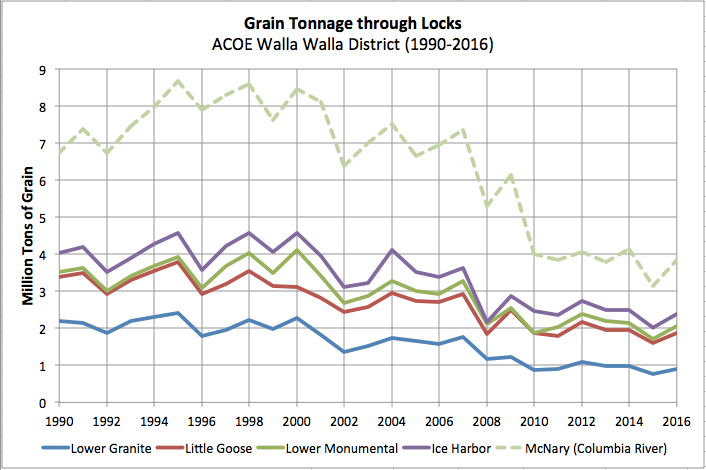forum
library
tutorial
contact

Snake River Dams Are
Assets That Must Remain
by Ron Dunning of the Port of Walla Walla
Walla Walla Union-Bulletin, March 28, 2015
|
the film forum library tutorial contact |

|
Snake River Dams Are
by Ron Dunning of the Port of Walla Walla
|
 The Walla Walla Union-Bulletin has recently printed several letters to the editor from citizens supporting the removal of the Lower Snake River dams. A new environmental group at Whitman College has been formed for the same purpose.
The Walla Walla Union-Bulletin has recently printed several letters to the editor from citizens supporting the removal of the Lower Snake River dams. A new environmental group at Whitman College has been formed for the same purpose.
The arguments they use to support dam removal are flawed.
The notion that breaching the Snake River dams would save taxpayer money, while increasing "recreation" money and by reference exceed the current benefits of hydropower and barging flies in the face of every objective academic study done by actual experts.
Dam-breaching proponents claim investments in wind generating capacity have made hydropower redundant. Perhaps they are referring to the Northwest Power & Conservation Council's 2014 report that states wind energy added 1,906 MW of new generating capacity.
What they failed to mention is that same report lists hydropower as providing 62,336 MW, or 53 percent of our total generating capacity.
Additionally, hydropower provides critical peaking capacity to the Northwest, to meet high energy demands almost immediately. Wind energy simply can't respond in that way.
(bluefish notes: Nor can the Lower Snake River dams provide "critical peaking capacity to the Northwest". These four dams are "run-of-river" dams that do not provide such flexibility as do the region's large storage dams such as Chief Joseph and Grand Coulee.)The Snake River dams and the carbon-free electricity they produce are a critical part of our regional energy portfolio.
The Columbia Snake River System is the top wheat export gateway in the nation. Of the wheat moving by barge down the river for export, 54 percent moves through one or more of the four Lower Snake River dams.
Barging on the Columbia Snake River System moves 9 million tons of cargo valued at $3 billion each year. Our river system allows communities in Eastern Washington and beyond to export their goods to countries throughout the world, and keeps our farmers and others competitive in the global marketplace.
(bluefish notes: The above chart of more recent shipping data calls into question the veracity of Dunning's assertions regarding wheat shipments.)While dam-breaching proponents make their case in environmental terms, no true environmentalist would advocate removing barging as a transport option.
One barge tow carries the equivalent of 538 trucks worth of tonnage. Barging is the safest, most efficient and most environmentally friendly method of cargo transport available today.
A barge can move one ton of wheat 576 miles on one gallon of fuel. Barging has lower exhaust emissions than rail or truck.
(bluefish notes: Since 1992, railroad has actually been more energy efficient than barging. See Energy Intensities of Freight: Barge, Truck and Railroad US Department of Energy, Center for Transportation Analysis. Moreover, barge operators do not pay electric ratepayers for more than $1 million in foregone power revenues due to energy lost through lockages. See Electric Power Foregone to Lock Flush by Oregon Natural Resource Council)Rhetoric is no match for facts. The inland river system is a robust multiuse system that supports hydropower, navigation and recreation, balanced with fish and wildlife needs.
At a time when we have more demand than ever on our surface transportation systems, our region is the envy of other areas that do not have barging, and must rely on trucking and rail.
Most in the region are excited to celebrate historic collaborative efforts that are yielding record returns for our iconic salmon runs. We encourage those who care about fish, energy, trade and recreation to join in that collaboration.
Related Pages
Adult Salmon Survival Past Dams is 99 Percent by John McKern, Walla Walla Union-Bulletin, 3/25/15
Fish Survival Rate is Disputed by Borg Hendrickson, Walla Walla Union-Bulletin, 3/21/15
Idaho Needs and Can Maintain Both Its Dams and Fish by David Doeringsfeld, Lewiston Tribune, 3/15/15
Hydropower Not Been Replaced by Wind Power by John McKern, Walla Walla Union-Bulletin, 3/6/15
New Numbers Won't Change Debate About Snake River Structures by Rocky Barker,
Idaho Statesman, 3/5/15
Lower Snake River Dams Are Economic Losers by Borg Hendrickson, Walla Walla Union-Bulletin, 2/28/15
Related Pages
(ISAB 2015-1)Density Dependence and its Implications for Fish Management and Restoration in the Columbia River Basin by Independent Scientific Advisory Board, Erik Merril 2/25/15
learn more on topics covered in the film
see the video
read the script
learn the songs
discussion forum
